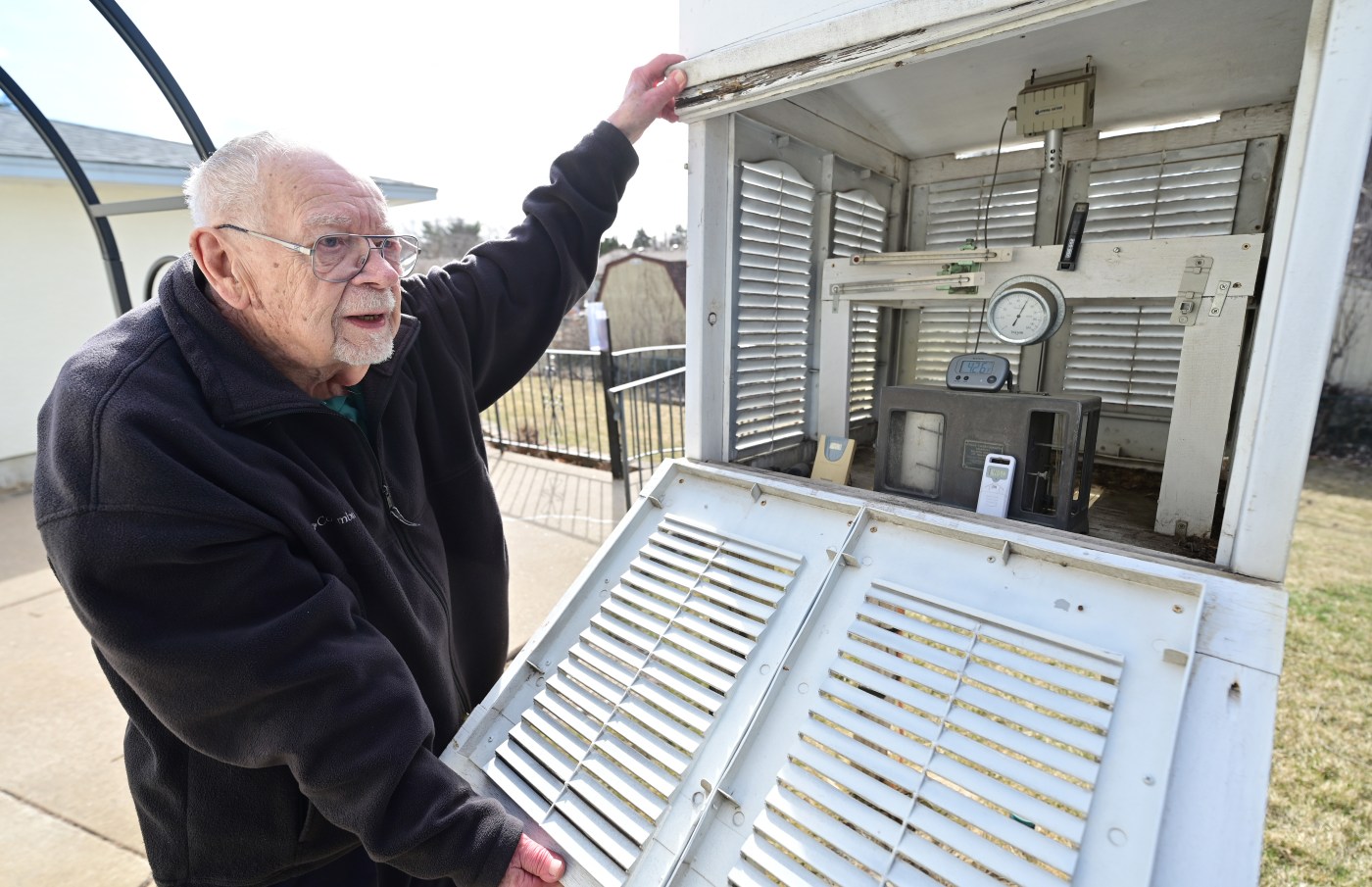
‘It’s boring if nothing exciting happens.’ North St. Paul volunteer meteorologist revels in bad weather.
The temperature was 32 degrees at 4:30 p.m. Thursday at Dave Wierstad’s house in North St. Paul.
The relative humidity was 47 percent, the barometric pressure was falling and the solar radiation had an intensity of approximately 17 watts per square meter. The winds were coming from the east-northeast at 6 mph.
Wierstad, an amateur meteorologist, has been keeping detailed weather records at his house since March 25, 1962. He is a longtime volunteer with the Community Collaborative Rain, Hail and Snow Network, or CoCoRaHS for short, which is coordinated by the State Climatology Office.
Wierstad uses a Davis Vantage Pro2 weather station, mounted on a 3/4-inch steel pole that rises 30 feet over his garage, to track real-time wind speeds, wind direction, wind chill, temperature and humidity, barometric pressure, rainfall, heat index, dew point, solar intensity and the UV index.
Each reading is sent automatically to his computer, and Wierstad’s weather website – www.wierstad.com – is updated every 15 minutes.
Wierstad, 87, a retired gas dispatcher for Northern States Power (now Xcel Energy), also checks a second, 4-inch-diameter rain gauge installed on a cedar fence post on his back deck – “where the wind won’t splash out water” – whenever it rains.
In winter, he uses a 30-inch metal ruler to measure snowfall in his yard. He also melts and measures the snow that falls into his rain gauge to ascertain the water content of the snow.
He sends a daily report to CoCoRaHS, the rainfall monitor volunteer program.
CoCoRaHS volunteers
The data gathered by Wierstad and other observers are invaluable to state climatologists as they work on drought monitoring, flood management and for verifying high rainfall totals, said Luigi Romolo, the state climatologist.
Volunteers with CoCoRaHS measure precipitation in their back yards using 4-inch-diameter rain gauges.
The program, which launched in Colorado after a flash flood in 1997 killed five people, has been a success because “Minnesotans care about their weather,” Romolo said.
An old NSP Gas clipboard holds sheets of detailed weather observations made by Dave Wierstad at his North St. Paul home. (John Autey / Pioneer Press)
CoCoRaHS maps daily online reports from thousands of people nationwide. About 1,200 Minnesota residents participate, with about 400 to 800 regularly contributing data, Romolo said.
Rainfall and snowfall amounts can vary widely over a short distance, so a variety of reports is helpful in the same community or area, according to Romolo.
Take July 26, 2023, for example. Two observers in Woodbury reported approximately 2 inches of rainfall, but only about half an inch was reported in the Stillwater area, he said. Wierstad, for the record, recorded 46 hundredths of an inch in North St. Paul.
“Getting that understanding of the spatial variation of the precipitation is really important for us, particularly across the metro area,” he said. “That’s where impacts for flash flooding are critical.”
More volunteer reports make the state’s precipitation maps more accurate and “provide critical guidance on our changing climate,” Romolo said. “The more gauges that we have here on the ground, the more likely we are to be able to assess what’s going on in a specific location.”
Some areas of the state, especially west-central Minnesota, have very few reporting stations, he said.
“We’re looking for more volunteers,” he said. “The more we have, the better information we all have. We’re going to keep doing this until there is a gauge in every back yard.”
Each reporter is asked to use a standard 4-inch-diameter plastic rain gauge for official rainfall measurements; they can be found online for about $35, Romolo said.
Related Articles
A geologist and a civil engineer found a prehistoric creek in St. Paul. Now they want to restore it.
Airplane ‘sounded much lower than it should have been.’ NTSB releases preliminary report on fatal Afton crash.
Central High softball players exceed initial fundraising goal to visit vice president in D.C.
St. Paul seeks design, engineering experts to advance River Learning Center in Hidden Falls
What could be the season’s biggest snowstorm winds up, nearly a foot of snow possible in the Twin Cities
“We ask that people get that specific rain gauge because that allows us to make accurate comparisons,” he said. “If people are using different rain gauges, then it makes it really hard – you’re comparing apples and oranges.”
Volunteers receive training on how to observe weather trends and how to submit their precipitation and weather-event reports; all training material is available online. Participants must have internet access to submit reports, he said.
For the past four years, Minnesota has won the “CoCoRaHS Cup” for recruiting the most new volunteers of any state.
“We’re hoping Minnesotans will again come through in 2024 to keep the cup in Minnesota and, more important of course, to improve our state’s precipitation recording,” Romolo said.
1951 tornado
Wierstad, who grew up in St. Paul, said his fascination with weather started when he was around 12. That’s when he made a rain gauge out of an old Maxwell House coffee can and used a Prestone antifreeze can to shelter a thermometer. He also asked his dad, Roy, to build a weathervane for him, he said.
“I put it up on a 30-foot pole in the back yard with some guy wires to stabilize it in case there was a heavy wind,” he said.
He was 15 when a major tornado struck the Twin Cities on July 20, 1951.
“There were big cottonwood trees that were, like, 100 feet tall, and they were bending over like this,” he said, bending his arm at nearly 90 degrees. “It knocked out the power at the Weather Bureau station at the airport (then Wold-Chamberlain Field, now Minneapolis-St. Paul International Airport), and it blew the rain gauge off the roof. The winds got up to 98 miles per hour. I thought, ‘How is this happening?’ That’s how I got interested in this.”
Wierstad said he thought about going into meteorology, but “you had to be proficient in math and science, and I could never understand math too much, so I never got into it,” he said.
Wierstad said he started noticing about 15 years ago that winters are becoming warmer on average and summers are becoming “a little bit cooler than normal.”
“That’s what my records show at my station here,” he said. “I like it. As you get older, I like the warmer winters and, generally speaking, there is less snow, except for last winter. I heard a long time ago that in 50 years, we will have the climate that St. Louis, Missouri, has.”
Wierstad’s basement office contains a wealth of weather information. He gets up between 4 and 5 a.m. each day to check the data; he makes his CoCoRaHS report about 6:30 a.m., he said.
Dave Wierstad in the amateur weather station at his North St. Paul home. Outdoor instruments send rain, wind, humidity, solar intensity, UV index and temperature readings to his computer, and his website is updated every hour on the hour. (John Autey / Pioneer Press)
One of his four computer monitors displays his security-camera footage; it doubles as a weather-observation camera during weather events, he said.
“You can see heavy snow, and rain when it gets really bad,” he said. “One day, I was down here about 6 o’clock in the morning, and we had a big thunderstorm going through. You could see the whole Northern Hemisphere flashing with lights. I got pictures of that.”
Maria Wierstad said she is in full support of her husband’s hobby. The couple had three children; their son, David, died in 2006. They have seven grandchildren and 10 great-grandchildren.
“I think it’s great that he can still do it,” he said. “He’s had a heart-valve replacement, and a pacemaker put in. He had a stroke a few years ago, and the first thing he wanted to do when he came home was to go down to the basement. I told him he had to wait a day or two.”
Maria Wierstad said she has never had to ask him about the weather because there are monitors set up on each floor of their two-story house. Dave Wierstad said he also can check everything on his cellphone.
“No matter where I am, I know what it’s like in North St. Paul,” he said.
Wierstad said he likes that his hobby keeps his mind sharp and gives him a reason to get up in the morning.
“It keeps your mind active,” he said. “I mean, you have to be thinking, and you’re recording, and you’re taking down the numbers, and you’re writing them all down, and you’re reading.”
The best part, however, is the variety, he said.
“Every day, it’s something different,” he said. “The weather is changing constantly. It’s boring if nothing exciting happens. I like to have some rain and thunderstorms. The snow is coming now on Sunday. That will be a big one. We might get a thunderstorm, too. That should be fun.”
How to volunteer
Volunteers are needed for the Community Collaborative Rain, Hail and Snow Network.
To sign up or for more information, visit CoCoRaHS.org or contact Luigi Romolo at luigi.romolo@state.mn.us.
Related Articles
Central High softball players exceed initial fundraising goal to visit vice president in D.C.
Vice President Kamala Harris invites Central High School softball players to Washington
Homelessness down 7% in Minnesota since 2018, study says
Anna Peterson named vice president of people and culture at Twin Cities Habitat for Humanity
GoFundMe for indicted girlfriend of Burnsville shooter now dedicated to her kids only, organizer says


